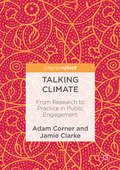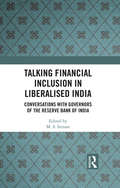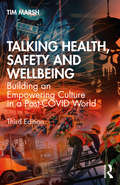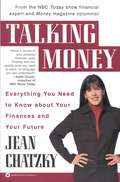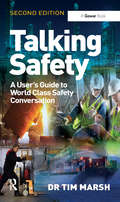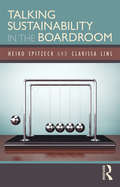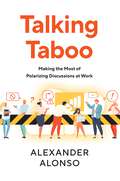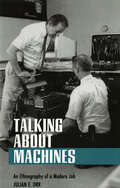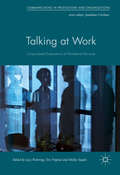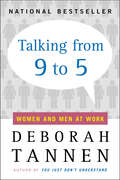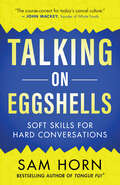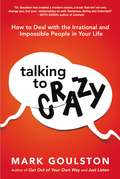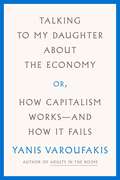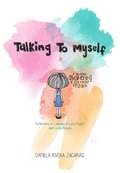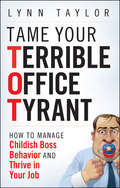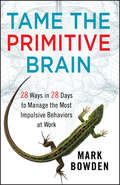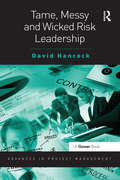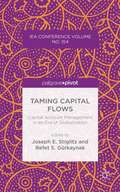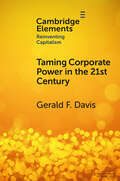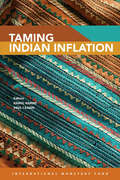- Table View
- List View
Talking Climate: From Research to Practice in Public Engagement
by Adam Corner Jamie ClarkeThis book describes a fresh approach to climate change communication: five core principles for public engagement that can propel climate change discourse out of the margins and into the mainstream. The question of how to communicate about climate change, and build public engagement in high-consuming, carbon-intensive Western nations, has occupied researchers, practitioners, and campaigners for more than two decades. During this time, limited progress has been made. Socially and culturally, climate change remains the preserve of a committed but narrow band of activists. Public engagement is stuck in second gear. By spanning the full width of the space between primary academic research and campaign strategies, this book will be relevant for academics, educators, campaigners, communicators and practitioners.
Talking Financial Inclusion in Liberalised India: Conversations with Governors of the Reserve Bank of India
by M. S. SriramThis book presents a set of conversations with five former Governors of Reserve Bank of India (from 1992 onwards) on the topic of financial inclusion. Two key aspects are introduced in the conversations with each Governor: the initiatives that were undertaken during their tenure and their responses to some of the current issues. Further, they examine the reasons and justifications for significant decisions and measures that were undertaken or withheld. The discussion captures the evolution and approach of the central bank in addressing a variety of questions pertaining to financial inclusion. The volume is an important contribution to the study of India’s continuous but not entirely successful efforts in increasing the reach of its formal financial sector. It reconstructs how the policy approach to inclusive banking has progressed and resisted commercial and market imperatives to safeguard the deprived and dispossessed sections of society. With its wide-ranging blend of conversations, documentation, research and commentary coupled with its engaging style, the book will interest students and researchers in the areas of development, banking, macroeconomics, public administration and governance, as well as academics, analysts, policymakers, think tanks, journalists, media and those concerned with the Indian economic policy.
Talking Health, Safety and Wellbeing: Building an Empowering Culture in a Post-COVID World
by Tim MarshThe book considers what makes an excellent face-to-face health and safety contact in the workplace, and why these contacts are a fundamental building block of any strong, caring, and empowering workplace culture. It stresses the vital importance of inquiry, empathy, and analysis in understanding what employees need to mitigate risk factors around safety and mental health. This revised and updated edition includes empowering methodologies that directly address mental health and well-being issues and the challenges organisations face in a post COVID19 era. The reader will gain an understanding of the day-to-day mechanisms of why “culture is king” and how everyone contributes every-day to this truism. This book covers how interactions regarding leadership and teamwork directly lead to the amount of human error and fallibility an organisation can expect to need to manage, and how taking proactive, analytical, and empowering approaches to safety and health is key to identifying and mitigating risks. Talking Health, Safety and Wellbeing explains why it is so important to talk about health and safety issues proactively. Written in an accessible and engaging manner, this book is an ideal read for any frontline supervisor, HR manager, mental health first aider, safety rep, or company director.
Talking Money: Everything You Need to Know About Your Finances and Your Future
by Jean ChatzkyToday everyone is talking about money: how to spend it, how to save it, and how to invest it. But how much of this wall-to-wall money talk really makes sense? And how much of it has anything to do with you? Now America's best known and most trusted personal finance expert brings her down-to-earth style to a book for real people with real issues about money. Jean Chatzky wants you to grab a cup of coffee, pull up a chair, and start . . . TALKING MONEY The bad news is that many of us just don't "get" money--or our own financial situations. The good news, says Jean, is that "there is very little about money that can't be explained in terms of sixth-grade math and plain English." In the pages of this refreshing and informative book, she helps you bring clarity and sanity to your financial life. Here Jean uses her personal experience and professional knowledge to explain everything from credit to equity, bond funds to college savings plans. And always, Jean not only gives you the facts, she shows you how to start making choices that are just right for you and your family. Learn to:7 Manage your money--and stop letting it manage you7 Accura
Talking Safety: A User's Guide to World Class Safety Conversation
by Tim MarshTalking Safety summarises in a short user-friendly read the key element of safety leadership - the management and supervisor 'walk and talk'. Safety standards are set by a combination of three things: first, the basic systems: risk assessments, procedures, training, inductions and maintenance; second, the amount of objective learning about the inevitable weaknesses in these systems achieved from a ’Just Culture’ perspective; and third, the quality of ’transformational’ safety leadership which means coaching not telling, praising not criticising, leading by example and maximising front-line ownership and involvement. A good ’walk and talk’ is the only methodology that covers all of these issues and really should be embedded as ’part of the way we do things around here’. It is the centrepiece of any world class safety culture. Although covering all the key safety research findings by academics including Sidney Dekker, Andrew Hopkins and James Reason as well as latest influencing skills techniques from recent advances such as ’nudge’ theory it is written in an accessible style using everyday examples and case studies. You can use any of the five simple steps it outlines to make a difference day to day. Employ its advice fully and it will help you embed safety thinking, transform your safety culture and make safety part of ’the way we do things around here’.
Talking Sustainability in the Boardroom
by Heiko Spitzeck Clarissa LinsA Global CEO study by Accenture and the UN Global Compact has shown that 94% of CEOs think that their board should discuss sustainability. And yet there is a real danger that boards are not living up to expectations on sustainability, paying lip-service to the concept rather than fully embedding social and environmental issues into their strategies and operations. Talking Sustainability in the Boardroom sets out why this is the case, identifies the obstacles, and then explains the opportunities for the long-term performance of the organisation that can arise through focusing on social and environmental issues. Written by two leading specialists in sustainability who have significant experience of working directly with boards, this book presents a very practical framework for embedding sustainability into board conversations and strategies. Steps include identifying and prioritising the social and environmental issues that are most pertinent to the organisation and will have the biggest impact on business, presenting the competences and skills to enable this, guidance on how to structure board meetings to ensure that these conversations truly take place, and the development of action plans and tools for measurement.
Talking Taboo: Making the Most of Polarizing Discussions at Work
by Alexander AlonsoWhat happens when polarizing topics surface in the workplace? It depends on how we handle them. In Talking Taboo, SHRM Chief Knowledge Officer Dr. Alexander Alonso explores why certain topics - like politics, race, religion, sex, and gender - are often considered off-limits at work, and what happens when they inevitably arise. Drawing on insights from the "2020 SHRM Survey of Politics and Polarizing Discussions in the Workplace", Alonso offers real-world dialogue examples, research-based findings, and practical tools to assess, manage, and engage in difficult conversations constructively.This timely and essential guide helps leaders and teams move beyond discomfort to create more inclusive, thoughtful, and resilient workplace cultures.
Talking about Machines: An Ethnography of a Modern Job
by Julian E. OrrThis is a story of how work gets done. It is also a study of how field service technicians talk about their work and how that talk is instrumental in their success. In his innovative ethnography, Julian E. Orr studies the people who repair photocopiers and shares vignettes from their daily lives. He characterizes their work as a continuous highly skilled improvisation within a triangular relationship of technician, customer, and machine. The work technicians do encompasses elements not contained in the official definition of the job yet vital to its success. Orr's analysis of the way repair people talk about their work reveals that talk is, in fact, a crucial dimension of their practice. Diagnosis happens through a narrative process, the creation of a coherent description of the troubled machine. The descriptions become the basis for technicians' discourse about their experience, and the circulation of stories among the technicians is the principal means by which they stay informed of the developing subtleties of machine behavior. Orr demonstrates that technical knowledge is a socially distributed resource stored and diffused primarily through an oral culture. Based on participant observation with copier repair technicians in the field and strengthened by Orr's own years as a technician, this book explodes numerous myths about technicians and suggests how technical work differs from other kinds of employment.
Talking at Work
by Eric Friginal Lucy Pickering Shelley StaplesThis book offers original corpus research in a range of workplace contexts including office-based settings, call center interactions and healthcare communication. Chapters in this edited volume bring together leading scholars in the field of corpus analysis in workplace discourse and include data from multiple corpora. Employing a range of qualitative and quantitative analytic approaches including Conversation Analysis, Linguistic Profiling and Register Analysis, the book introduces unique specialized corpus data in the areas of Augmentative and Alternative Communication, nursing, and cross-cultural communication, among others.
Talking from 9 to 5: Women and Men at Work
by Deborah Tannen“Required reading…sharp and insightful…lively and straightforward…a novel and sometimes startling analysis of workplace dynamics.”—New York Times Book ReviewIn her extraordinary international bestseller, You Just Don’t Understand, Deborah Tannen transformed forever the way we look at intimate relationships between women and men. Now she turns her keen ear and observant eye toward the workplace—where the ways in which men and women communicate can determine who gets heard, who gets ahead, and what gets done. An instant classic, Talking From 9 to 5 brilliantly explains women’s and men’s conversational rituals—and the language barriers we unintentionally erect in the business world. It is a unique and invaluable guide to recognizing the verbal power games and miscommunications that cause good work to be underappreciated or go unnoticed—an essential tool for promoting more positive and productive professional relationships among men and women.
Talking on Eggshells: Soft Skills for Hard Conversations
by Sam HornSilver winner of the 2023 Foreword INDIES award for business & economics by Foreword Reviews Want to know how to speak up instead of shut down, face challenges head-on instead of run the other way, and keep your cool even when others don’t? Talking on Eggshells shows you how. This inspiring book shares everyday character-building situations and offers examples of what to say and not to say so you’ll never be tongue-tied or tongue-twisted again. Sam Horn’s relatable, real-life stories and energizing, instantly usable insights will help you think on your feet, reduce stress, and deal more proactively and diplomatically with bosses, coworkers, customers, friends, family members, partners, children, even that date who just ghosted you. You’ll love this go-to guide for clearly communicating what you want and need to get the results you desire and deserve.
Talking to 'Crazy': How to Deal with the Irrational and Impossible People in Your Life
by Marshall Goldsmith Mark Goulston“[Goulston’s]ideas are a bit counter-intuitive but they really do shift the dynamic and help people diffuse and disarm the irrational person leading to more positive outcomes.” -- Online MBA Because some people are beyond difficult… Let’s face it, we all know people who are irrational. No matter how hard you try to reason with them, it never works. So what’s the solution? How do you talk to someone who’s out of control? What can you do with a boss who bullies, a spouse who yells, or a friend who frequently bursts into tears? In his book, Just Listen, Mark Goulston shared his bestselling formula for getting through to the resistant people in your life. Now, in his breakthrough new book Talking to Crazy, he brings his communication magic to the most difficult group of all—the downright irrational. As a psychiatrist, Goulston has seen his share of crazy and he knows from experience that you can’t simply argue it away. The key to handling irrational people is to learn to lean into the crazy—to empathize with it. That radically changes the dynamic and transforms you from a threat into an ally. Talking to Crazy explains this counterintuitive Sanity Cycle and reveals: Why people act the way they do • How instinctive responses can exacerbate the situation—and what to do instead • When to confront a problem and when to walk away • How to use a range of proven techniques including Time Travel, the Fish-bowl, and the Belly Roll • And much more You can’t reason with unreasonable people—but you can reach them. This powerful and practical book shows you how.
Talking to My Daughter About the Economy: or, How Capitalism Works--and How It Fails
by Yanis Varoufakis Jacob MoeIn Talking to My Daughter About the Economy, activist Yanis Varoufakis, Greece’s former finance minister and the author of the international bestseller Adults in the Room, pens a series of letters to his young daughter, educating her about the business, politics, and corruption of world economics. Yanis Varoufakis has appeared before heads of nations, assemblies of experts, and countless students around the world. Now, he faces his most important—and difficult—audience yet. Using clear language and vivid examples, Varoufakis offers a series of letters to his young daughter about the economy: how it operates, where it came from, how it benefits some while impoverishing others. Taking bankers and politicians to task, he explains the historical origins of inequality among and within nations, questions the pervasive notion that everything has its price, and shows why economic instability is a chronic risk. Finally, he discusses the inability of market-driven policies to address the rapidly declining health of the planet his daughter’s generation stands to inherit. Throughout, Varoufakis wears his expertise lightly. He writes as a parent whose aim is to instruct his daughter on the fundamental questions of our age—and through that knowledge, to equip her against the failures and obfuscations of our current system and point the way toward a more democratic alternative.
Talking to Myself: Reflections on Learning to Love Myself and Living Bravely
by Daníela Rivera ZacaríasDaníela Rivera Zacarías believes everything happens for a reason, even if we cannot see it at the moment. This book began as her personal journal, her own attempt to discover her place in the world through analyzing experiences, relationships, and spiritual encounters. It evolved into a book—and then the beloved Hablando Sola brand with more than 2,100,000 Facebook likes—full of thoughtful questions and meaningful reflections that has inspired and uplifted hundreds of thousands of young people in Latin America. Now the book that has sold more than 200,000 copies in Latin America is available in English, coinciding with the brand’s expansion into the United States as Talking to Myself.Zacarías guides readers on their own self-discovery journeys through simple, accessible musings and anecdotes. "How do you learn to love yourself?” she asks and then continues, "I think it’s impossible if you don’t know who you are.” The ensuing chapters include Love, Fear, God, Art, Beauty, Depression, Happiness, and more, tackling a wide range of subjects with one goal in mind: helping readers to better know themselves, that they might better love themselves.This book comes alongside you like a big sister who’s been there and done that and can impart her wisdom between warm hugs and a few laughs. It will be of special interest to the 54 million Hispanic Americans in the United States because of Zacarías’s following in Latin America, but its honesty, warmth, and wisdom will give it broad appeal, particularly to young women.
Talking with the Groundswell: Spreading Positive Word of Mouth About Your Business Through Social Technology
by Charlene Li Josh BernoffCompanies spend millions on advertising, but with so many products jostling for attention, shouting at people isn't nearly as effective as it used to be. More to the point, social technologies have revved up the word-of-mouth dynamic, increasing the influence of regular people's comments on your product while diluting the value of traditional advertising. In this chapter, social media strategy leaders Charlene Li and Josh Bernoff will show you how to use the groundswell for marketing and PR, with techniques like user-generated video, blogs, and online communities. They also present vivid case studies from Blendtec, the company behind willitblend.com and its viral videos starring CEO Tom Dickson; Ernst & Young's Facebook presence and its success in engaging and recruiting recent college graduates; Hewlett-Packard's executive blogs, which enable customers to engage directly with company experts on virtually any aspect of HP's vast product line; and Procter & Gamble's Web site for girls, beinggirl.com, where P&G's youngest consumers of feminine care products have found a safe, fun, and supportive online community. This chapter was originally published as Chapter 6 of "Groundswell, Expanded and Revised Edition: Winning in a World Transformed by Social Technologies."
Tall: the design and construction of high-rise architecture
by John Sutherland Guy Marriage Nabil Jose Allaf Gerard Finch Lauren HayesThis is a guide to both the basics and the details of tall building design, delving into the rudimentary aspects of design that an architect of a tall office building must consider, as well as looking at the rationale for why and how a building must be built the way it is. Liberally illustrated with clear, simple black and white illustrations showing how the building structure and details can be built, this book greatly assists the reader in their understanding of the building process for a modern office tower. It breaks down the building into three main components: the structure, the core and the facade, writing about them and illustrating them in a simple-to-understand manner. By focusing on the nuts and bolts of real-life design and construction, it provides a practical guide and desk-reference to any architect or architecture student embarking on a tall building project.
Tamarin App: Natural Language Processing
by Srikant M. Datar Caitlin N. BowlerThis case was written for the EC course "Managing with Data Science." The course provides MBA students with no programming experience an introduction to the field of data science and its applications in business. Students learn to (1) carefully articulate the business ask, (2) reason carefully from the ask; through metrics and models, and outputs; and (3) evaluate outputs from models to (4) develop a plan for action. In this case students explore the challenges of using sentiment analysis to monitor and understand public perception around brands. Technical topics include building a filtering classifier using naive Bayes and sentiment analysis.
Tamarin SEO App
by Srikant M. Datar Caitlin N. BowlerThis case was written for the EC course “Managing with Data Science.” The course provides MBA students with no programming experience an introduction to the field of data science and its applications in business. Students learn to (1) carefully articulate the business ask, (2) reason carefully from the ask; through metrics and models, and outputs; and (3) evaluate outputs from models to (4) develop a plan for action. In this case students explore the challenges of using sentiment analysis to monitor and understand public perception around brands. Technical topics include building a filtering classifier using naive Bayes and sentiment analysis.
Tame Your Terrible Office Tyrant
by Lynn TaylorAn indispensable guide to dealing with challenging, childish boss behavior and building a great career, with laugh- out-loud humor built in. Based on extensive interviews among workers, managers and psychologists, Tame Your Terrible Office Tyrant™ draws hilarious but true parallels between toddlers and managers. When under stress, both often have trouble moderating their power, or lose the ability to think rationally. Traits in common include tantrum-throwing, demanding, stubborn, moody, fickle, self-centered, needy and whiny behavior. BADD (Boss Attention Deficit Disorder) is discussed as part of "Short Attention Spans. " There are 20 chapter traits in all, divided into "Bratty" and "Little Lost Lamb" categories, for easy reference, including real anecdotes and many useful tips. When bad bosses run amok in companies, nobody wins. This book shows readers how to build positive relationships with even the most out-of-control boss, and still thrive in your job. The key to success lies in dealing with a Terrible Office Tyrant (or TOT™) much like a parent deals with a troublesome toddler. With true stories and time-tested solutions, this is the perfect guide managing a boss stuck in his Terrible Twos. Taylor takes you behind all the bossy blustering, so that you can focus on getting ahead - and achieve career excellence. Savvy top management will also gain insight on what not to do with their team. They know that Terrible Office Tyrant (TOT) managers may not be in plain sight (they don't leave juice stains on the hallway carpet!) But they do wreak havoc on the bottom line. A special section helps senior management and Human Resource departments mitigate TOT behavior for a more productive workplace.
Tame the Primitive Brain
by Mark BowdenA new and simple system to understanding and controlling the behavior of othersNoted body language, behavior and communication expert Mark Bowden offers a totally practical, easy-to-read guide to understanding the impulsive actions of others, along with the best tools to manage them. A number one anxiety in business is dealing with problem people. In Tame the Primitive Brain, Mark Bowden's fresh approach is the fastest and most effective way to understand why someone acts towards you the way they do; why you react to their behavior in the way you do; and most importantly, what exactly to do about it to achieve the right outcomes.Brings new and fresh perspectives to business readers for dealing with tricky behaviorsExplains how to effectively manage those around you at any level in an organization Shares the latest evolutionary behavioral theory, neuroscientific evidence, and the tried and tested tools and tricks based on these premisesThis simple model of how we humans can and do relate to each other brings increased depth of understanding and expands your toolset to better manage yourself and others to achieve anything.
Tame, Messy and Wicked Risk Leadership (Advances in Project Management)
by David HancockThe general perception amongst most project and risk managers that we can somehow control the future is, says David Hancock, one of the most ill-conceived in risk management. The biggest problem is how to measure risks in terms of their potential likelihood, their possible consequences, their correlation and the public's perception of them. The situation is further complicated by identifying different categories of problem types; Tame problems (straight-forward simple linear causal relationships and can be solved by analytical methods), and 'messes' which have high levels of system complexity and have interrelated or interdependent problems needing to be considered holistically. However, when an overriding social theory or social ethic is not shared the project or risk manager also faces 'wickedness'. Wicked problems are characterised by high levels of behavioural complexity, but what confuses real decision-making is that behavioural and dynamic complexities co-exist and interact in what is known as wicked messes. Tame, Messy and Wicked Risk Leadership will help professionals understand the limitations of the present project and risk management techniques. It introduces the concepts of societal benefit and behavioural risk, and illustrates why project risk has followed a particular path, developing from the basis of engineering, science and mathematics. David Hancock argues for, and offers, complimentary models from the worlds of sociology, philosophy and politics to be added to the risk toolbox, and provides a framework to understand which particular type of problem (tame, messy, wicked or messy and wicked) may confront you and which tools will provide the greatest potential for successful outcomes. Finally he introduces the concept of 'risk leadership' to aid the professional in delivering projects in a world of uncertainty and ambiguity. Anyone who has experienced the pain and blame of projects faced with overruns of time or money, dissatisfied stakeholders or basic failure, will welcome this imaginative reframing of some aspects of risk management. This is a book that has implications for the risk management processes, culture, and outcomes, of large and complex projects of all kinds.
Taming Capital Flows: Capital Account Management in an Era of Globalization
by Joseph E. Stiglitz Refet S. GürkaynakThis volume contains country experiences explained by policy makers and studies by leading experts on causes and consequences of capital flows as well as policies to control these flows. It addresses portfolio flow issues central to open economies, especially emerging markets.
Taming Corporate Power in the 21st Century (Elements in Reinventing Capitalism)
by Gerald F. DavisThere is broad consensus across the political spectrum in the US that monopolistic corporations – particularly Big Tech companies -- have grown too powerful, and that we need to revive antitrust to take on the 'curse of bigness.' But both the diagnosis and the cure are rooted in an outdated understanding of how the American economy is organized. Information and communication technologies have fundamentally altered the markets for capital, labor, supplies, and distribution in ways that undermine the basic categories we use to understand the economy. Nationality, industry, firm, size, employee, and other fundamental terms are increasingly detached from the operations of the economy. If we want to understand and tame the new sources of economic power, we need a new diagnosis and a new set of tools.
Taming Indian Inflation
by International Monetary FundHigh and persistent inflation in India has presented serious macroeconomic challenges, such as widening the current account deficit, exposing India to global financial market turbulence, and slowing growth. A number of factors have caused high inflation, including food inflation feeding quickly into wages and core inflation, entrenched inflation expectations, sector-specific supply constraints (particularly in agriculture, energy, and transportation), pass-through from a weaker rupee, and ongoing energy price increases. This book analyzes various facets of Indian inflation and their implications for the conduct of monetary policy in India. In particular, given the role of food inflation in driving inflation dynamics in India, several chapters are devoted exclusively to analyzing and managing food inflation. Building on the analysis of inflation dynamics, the book discusses the role of monetary policy in taming inflation, particularly given the costs of high and persistent inflation in India.
Taming Japan's Deflation: The Debate over Unconventional Monetary Policy (Cornell Studies in Money)
by Gene Park Giacomo Chiozza Saori N. Katada Yoshiko KojoBolder economic policy could have addressed the persistent bouts of deflation in post-bubble Japan, write Gene Park, Saori N. Katada, Giacomo Chiozza, and Yoshiko Kojo in Taming Japan's Deflation. Despite warnings from economists, intense political pressure, and well-articulated unconventional policy options to address this problem, Japan's central bank, the Bank of Japan (BOJ), resisted taking the bold actions that the authors believe would have significantly helped.With Prime Minister Abe Shinzo's return to power, Japan finally shifted course at the start of 2013 with the launch of Abenomics—an economic agenda to reflate the economy—and Abe's appointment of new leadership at the BOJ. As Taming Japan's Deflation shows, the BOJ's resistance to experimenting with bolder policy stemmed from entrenched policy ideas that were hostile to activist monetary policy. The authors explain how these policy ideas evolved over the course of the BOJ's long history and gained dominance because of the closed nature of the broader policy network.The explanatory power of policy ideas and networks suggests a basic inadequacy in the dominant framework for analysis ofthe politics of monetary policy derived from the literature on central bank independence. This approach privileges the interaction between political principals and their supposed agents, central bankers; but Taming Japan's Deflation shows clearly that central bankers' views, shaped by ideas and institutions, can be decisive in determining monetary policy. Through a combination of institutional analysis, quantitative empirical tests, in-depth case studies, and structured comparison of Japan with other countries, the authors show that, ultimately, the decision to adopt aggressive monetary policy depends largely on the bankers' established policy ideas and policy network.
